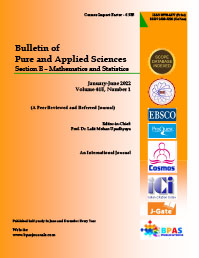Study of couple stresses on MHD Poiseuille flow through a porous medium past an accelerated plate ∗
DOI:
https://doi.org/10.48165/Keywords:
Couple stress, MHD, porous medium, accelerated plateAbstract
In this paper, we discuss an analytical study of the unsteady MHD flow of an incompressible electrically conducting couple stress fluid in the presence of porous medium between two parallel plates when the lower plate is accelerating while the upper plate is at rest, taking into account the pulsation of the pressure gradient effect and under the influence of a uniform magnetic field of strength B0. The solution to the problem is obtained with the help of the perturbation technique. Analytical expressions are given for the velocity field, the shear stresses on the boundaries and the discharge between the plates and the effects of the various governing parameters entering into the problem are reported graphically to depict the interesting aspects of the solution.
References
Annapurna, N. and Ramaniah, G. (1976). Effect of couple stresses on the unsteady drainage of a micro-polar fluid on a flat surface , Jpn. J. Appl. Phys., 15, 2441–2444.
Bujurke, N.M. and Naduvinamani, N.G. (1990). The lubrication of lightly cylinders in combined rolling, sliding and normal motion with couple stress fluid , Int. J. Sci., 32, 969–979. [3] Chaturani, P. (1978). Viscosity of Poiseuille flow of a couple stress fluid with applications to blood flow, Biorheology, 15, 119–128.
Nabil, T.M., El-Dabe, Salba and Mohandis, M.G. (1965). Effect of couple stresses on pulsatile hydromagnetic Poiseuille flow, Fluid Dynamics Research, 15(5), 313–324.
Edwards, M.F., Nelist, D.A. and Wilkinson, W.L. (1972). Pulsating flow of non-Newtonian fluids in pipes, Chem. Engg. Sc., 27, 545–553.
Gupta, R.S. and Sharma, R.L. (1988). Analysis of couple stresses lubricant in hydrostatic thrust bearings, Wear., 48, 257–269.
Kaladhar, K., Motsa S.S. and Srinivasacharya, D. (2016). Mixed convection flow of couple stress fluid in a vertical channel with radiation and Soret effects, Journal of Applied Fluid Mechanics, 9(1), 43–50.
Khodadadi, J.M. (1991). Oscillatory fluid flow through a porous medium channel bounded by two impermeable parallel plates, J. Fluids Engg., 133, 509–511.
Lin, J.R. and Hung, C.R. (2007). Combined effects of non- Newtonian couple stresses and fluid inertia on squeeze film characteristics between a long cylinder and an infinite plate, Fluid Dyn. Res., 39(8), 616–639. 58 Raj Shekhar Prasad, Rajnish Kumar and B.G. Prasad
Li-Wang, Qin-zhu and Zhu-Wen (2002). On the performance of dynamically loaded journal bear ings with couple stresses fluids, Tribology Int., 35, 185–191.
Makinde, O.D. and Eegunjobi, A.S. (2013). Entropy generation in a couple stress fluid flow through a vertical channel filled with saturated porous media, Entropy, 15, 4589–4606. doi:10.3390/e15114589.
Mindlin, R.D. (1973). Influence of couple stresses in linear elasticity, Exp. Mech., 20, 1–7. [13] Mindlin, R.D. and Tierstea, H.F. (1962). Effects of couple stresses in linear elasticity, Arch. Ration. Mech. Anal., 11, 415–448.
Mokhiamer, U.M., Crosby, W.A. and El-Gamel, H.A. (1999). A study of journal bearing lubricated by fluids with couple stresses considering the elasticity of the liner, Wear., 224, 194–201. [15] Naduvinamani, N.B., Hiremath, P.S. and Gurubasavaraj, G. (2005). Effects of surface roughness on the couple stress squeeze film between a sphere and a flat plate, Tribol. Int., 38(5), 451–458. [16] Naduvinamani, N.B., Hiremath, P.S. and Gurubasavaraj, G. (2002). Surface roughness effects in a short porous journal bearing with couple stress fluid, Fluid Dyn. Res., 31(5-6), 333–354. [17] Naduvinamani, N.B., Hiremath, P.S. and Gurubasavaraj, G. (2001). Squeeze film lubrication of a short porous journal bearing with a couple stress fluids, Tribol. Int., 34(11), 739–747. [18] Naduvinamani, N.B., Fatima, S.T. and Hiremath, P.S. (2003). Effect of surface roughness on characteristics of couple stress squeeze film between an isotropic porous rectangular plates, Fluid Dyn. Res., 32(5), 217–231.
Naduvinamani, N.B., Fatima, S.T. and Hiremath, P.S. (2003). Hydromagnetic lubrication of rough slider bearing with couple stress fluids, Tribol. Int., 36 (12), 949–959.
Prasad R.S. and Prasad, B.G. (2012). Study of couple stress fluid through porous medium in a parallel plate channel, IOSR Journal of Mathematics, 4(2), 10–17.
Ramanaiah, G. (1979). Squeeze films between finite plates lubricated by fluids with couple-stresses, Wear., 54, 315–320.
Rao Lakshman, S.K. and Iyengar, T.K.V. (1985). Analytical and computational studies in couple stress fluids flows, UGC Research project: C-8-482, SR-III. (This project was sanctioned at the Department of Mathematics, National Institute of Technology, Warangal 506 004, India.)
Rudraiah, N., Shankar B.M. and Ng, C.O. (2011). Electrohydromagnetic stability of couple stress fluid in a channel occupied by a porous medium, Special Topics and Reviews in Porous Media, 2(1), 11–22.
Sarojini, M.S., Krishna, M.V. and Uma Shankar, C. (2011). MHD flow of couple stress fluid through a porous medium in a parallel plate channel in presence of effect of inclined magnetic field, International Journal of Physics and Mathematical Sciences, 1(1), 9–18.
Stokes, V.K. (1966). Couple stresses in fluids, Phys. Fluids, 9, 1709–1715. [26] Stokes, V.K. (1971). Effects of couple stresses in fluids on the creeping flow past a sphere, Phys. Fluids., 14, 1580–1582.
Stokes, V.K. (1984). Theories of fluids with Microstructure, Springer, New York.
